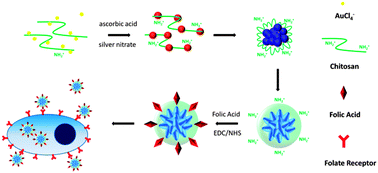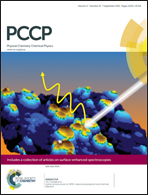Synthesis of size-tunable chitosan encapsulated gold–silver nanoflowers and their application in SERS imaging of living cells†
Abstract
Anisotropic metallic nanoparticles (NPs) possess unique optical properties, which lend them to applications such as surface-enhanced Raman scattering (SERS). However, their preparation by an efficient, biocompatible and high yield synthetic method is still challenging. In this work, we demonstrate a simple and reproducible way to produce chitosan (CS) encapsulated gold–silver nanoflowers by sequentially adding chitosan, chloroauric acid, silver nitrate, and ascorbic acid to water at room temperature. This is a one-pot, seed- and surfactant-free synthetic method, which is simple and credible. CS is used to modulate the size of NPs, while AgNO3 is introduced to improve the monodispersity and homogeneity of NPs. Highly sensitive, spectrally and physically stable SERS tags are developed in virtue of the cooperative effect of CS and Ag+. Cresyl violet (CV) is applied as a Raman reporter to test the SERS property of NPs, and the results demonstrated that the nanoflowers exhibited stronger and more stable SERS signals than those of spherical gold nanoparticles. Importantly, after being modified by tumor cell-specific targeting ligands (folic acid), the sensitive and stable labeled nanoflowers are applied for cancer cell targeting and SERS imaging.

- This article is part of the themed collection: Surface-enhanced spectroscopies

 Please wait while we load your content...
Please wait while we load your content...